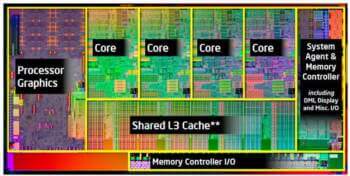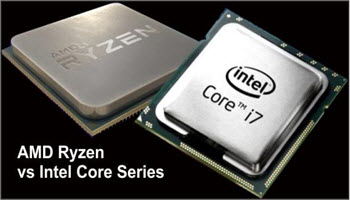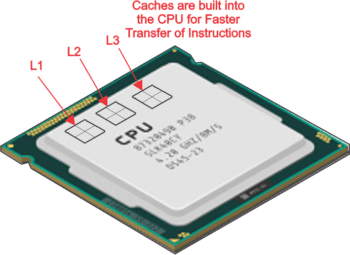Inside A CPU

Sometimes, only the chip name will be given by retailers. For example, “PC with i5 processor.” However, there are other descriptors of which you should be aware. A great source for consumers trying to decide is the website “CPU User Benchmark” Just enter a CPU’s name like “i7” and it will instantly compare all variations of the i7. It would be logical to believe that the more a CPU costs the better it is, or that a higher version is faster but that is not always the case. If you purchase a PC where they allow you to select a different CPU, make sure you are paying for features you will use. 
CPU Properties
There are several properties that determine a CPU’s value and can make a big impact on your PC’s performance. Hopefully, this article will help you understand some of the CPU’s properties.
Clock Speed is often the only thing considered when deciding but other factors like overclocking, hyperthreading, Cores, Cache, and Integrated Graphics should be considered.
- Clock Speed
- The clock speed of a CPU is often the first thing a consumer checks, but it doesn’t tell the whole story. Clock Speed is measured in GHz which stands for Gigahertz. If we break down the word, the first part, Giga, stands for one billion and hertz means “times per second”. Therefore, if we have a CPU rated at 2.7 GHz it can transmit data at 2 billion, 700 thousand times per second and a CPU rated at 3 GHz is a faster CPU. Note: When comparing clock speed, it is only meaningful if compared along the same product line. [i5 vs i5] An i7’s clock speed might be slower than a specific i5’s but still be faster because of other improvements in its architecture.

- CPUs are either rated as “Locked” or “Unlocked”. Unlocked means that the CPU can be overclocked. In simplest terms, it means that a CPU can be adjusted by the user to run at a faster GHz than the rating posted for the chip. The benefits of overclocking can be impressive, but they produce more heat and might require additional cooling capabilities. Overclocking will result in faster rendering times and can increase your CPU performance by 5 to 20%.
- The clock speed of a CPU is often the first thing a consumer checks, but it doesn’t tell the whole story. Clock Speed is measured in GHz which stands for Gigahertz. If we break down the word, the first part, Giga, stands for one billion and hertz means “times per second”. Therefore, if we have a CPU rated at 2.7 GHz it can transmit data at 2 billion, 700 thousand times per second and a CPU rated at 3 GHz is a faster CPU. Note: When comparing clock speed, it is only meaningful if compared along the same product line. [i5 vs i5] An i7’s clock speed might be slower than a specific i5’s but still be faster because of other improvements in its architecture.
- The number of Cores
- A core can be counted as an additional CPU. A quad-core processor will show up as 4 CPUs in your system even though they are contained within a single chip
- The core count can be very important. Four cores were considered adequate for most gamers but CPUs with 6 or 8 cores are the future of gaming and software with high processing demands. They are designed to take advantage of 8 or more cores. Programs like Photoshop and business applications are examples
- Hyperthreading
- Hyperthreading is the process of using a single core to process two sets of instructions at the same time, doubling the chip’s processing speed. A 6-core processer with hyperthreading effectively giving you 12 cores can really improve the performance for certain applications. Your software must be able to support hyperthreading. An excellent explanation of the benefits of multiple cores and hyperthreading can be found in this YouTube Video
- Cache size
- Cache on a processor can remember your most recent tasks, making repeated tasks execute extremely fast
- Cache size is rated in three tiers with the first “L1” always being the smallest and the fastest. L3 is usually the slowest and largest. However, most specifications only list the total cache size. 1MB or more of cache is optimal but even a 256KB cache will improve a CPU’s performance

- Integrated Graphics
Summary
When buying a laptop, if the CPU is a ball and solder system, they can’t be replaced and even PCs with changeable CPUs are limited by the motherboard’s speed capability. With desktops, you do have more options, but motherboard specs still apply. I recommend getting the best CPU and system you can afford. You never want it to be the bottleneck that limits the performance of your computer in the future. Memory and Hard Drives are easy to upgrade. A CPU’s Clock Speed can open programs and transfer instructions faster. Additional Cores are better for multitasking and keeping programs open without a reduction in clock speed.
See other articles in this series:
- Purchasing Your 2022 Computer
- Purchasing Your 2022 Computer – CPUs
- Purchasing Your 2022 Computer – The CPU – Part 2 ⬅ You are here
- Purchasing Your 2022 Computer – Memory
- Purchasing Your 2022 Computer – Storage
- Purchasing That 2022 Computer – Final Installment




As you detailed here, there are many attributes that go into selecting the best CPU for your computer. The number of cores and threads can be especially helpful, as these factors ensure smooth operation even when multiple apps are active.
Hi Rob, you are of course correct. In the final section of this series, I introduced a site that will let you compare your current PC to thousands of others and it will let you build a PC based on what you want in your next PC and compare it as well. You can break down CPUs, SSDs, GPUs, and more.